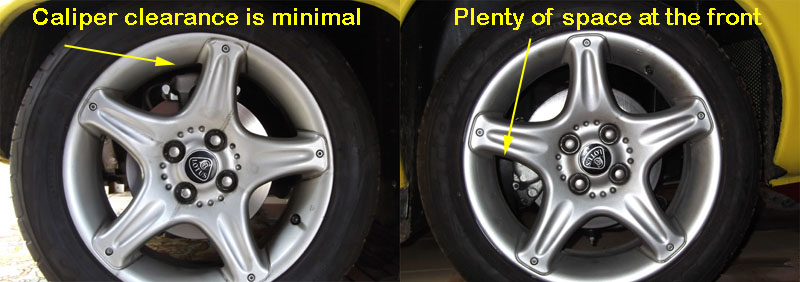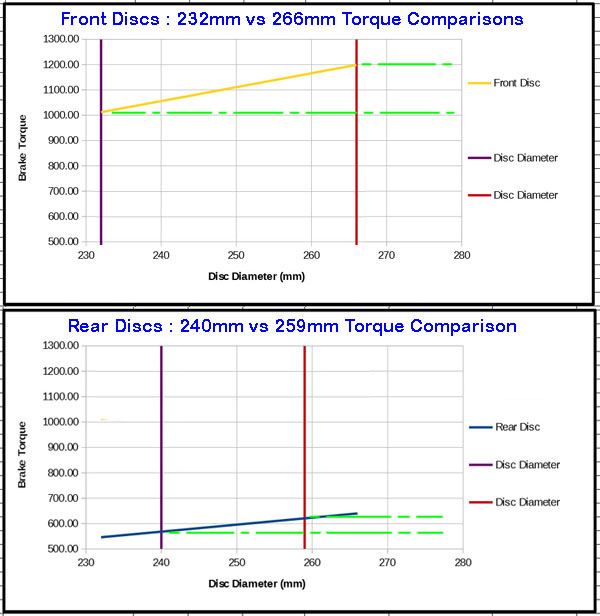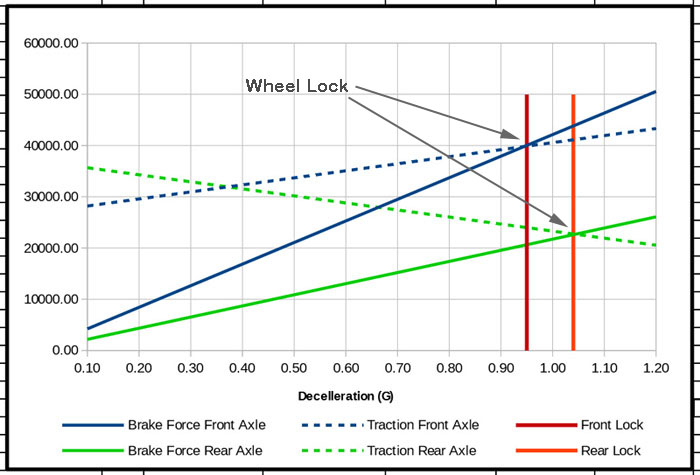
How it turned out, what it cost and the sums behind it all
As you can see from the first composite image, the clearances between the wheel and caliper are very tight at the rear and surprisingly larger at the front. It's partially down to the rear caliper bulk and how far it encroaches into the wheel, so as far as this set-up goes it's probably on the limit for the discs.

What it looks like with the (15") wheels in place
At the front we have more clearance so in theory could go slightly larger on discs. But, as with the rear, we're at the limit with Type 14 calipers due to the caliper body design.
A larger disc would mean grinding metal away from the caliper body, something I won't do. So larger discs would mean a different caliper which basically throws the whole package back into design mode.
The Project Manager suggests I stick with this set-up for now.... :)
So, how long did I spend in the workshop ?
Making the templates, probably no more than an hour in total. This was speeded up by cutting the centre out of an old Front Disc with a grinder, so much that if I did it again I’d be tempted to cut up a new disc !
Welding and tidying, about 3 days. I don’t work 8 hour days and I’m pretty slow so if you said 15-16 hours from steel to painted bracket that would be about right.
Materials
Overall a remarkably cheap project considering the final results. Say £70 all in ?
The Sums Behind It All
Before getting into these calculations I’ve got to point out a few things. Please bear in mind that they may not (and probably won’t) transfer directly to your car. My car is modified with 15” wheels, 195/50 and 205/50 tyres and stiffer suspension, so the braking performance will be different from someone with standard wheels and tyres.
Even the brake pad materials you use front/rear can have a significant effect on how the car balances and which end locks first.So just take the principles as ideas to work from and improve as you see fit.
Right, so how much improvement can you get from just putting a larger diameter disc in there ?

Brake Torque vs Disc Diameter at 70psi Pedal Pressure
The above graphs show the brake torque for a given pedal pressure (70psi) on both front and rear discs over a range of disc diameters. The YELLOW line is for the front and the BLUE line is for the rear axle.
The two vertical lines on the top chart show the 232mm OEM disc and the 266mm proposal. That’s quite a jump in available torque and perhaps too much ? Can you ever have too much ? We’ll check that later.
The lower chart shows the rear discs where there is still an improvement but obviously won't look as impressive in terms of outright numbers.
But we have a notably greater increase at the front than rear. We need to see if this upsets the balance of the car under dynamic loads, which is where the next chart comes in....

Brake Performance
This graph is trying to compare the brake forces required at the front and rear axles over a series of deceleration rates with the traction forces at the axles. Now I’ll admit that I didn’t work this out but used the spreadsheet from the previous rear disc conversion with a few additions from Fred Puhn's book plus my own car data.
The X axis has the deceleration rates given as “G” and most sports cars can pull between 0.8G and 1.2G. I found road test reports varying between 0.93G and 1G for the Europa. The actual numbers depend on lots of things, frictional surfaces, tyres, etc, so don’t take the numbers in this graph as 100% accurate but it does serve as a comparison between front and rear brakes.
As you brake harder you transfer more weight from rear to front, increasing front traction and reducing rear traction. What you don’t want to happen is that you transfer so much weight forwards that the rear tyres lose traction and the rear wheels lock before the front. This could come about by having a rear piston area or rear disc diameter larger than required.
So, with this disc combination we have theoretical lock at 0.95G Front, 1.05G rear.
In comparison, on the same assumptions the 232mm disc/rear drum OEM set up gives 0.8G front but no lock up at the rear, which probably explains the ease with which you can lock up the standard Europa brakes if you’re not careful. The S2 is different of course but similar in principle.
The 232/240mm disc combination I had previously came out at 0.93G Front, 1.04G rear, quite similar.
I must reiterate, please don’t take these numbers as the absolute truth. There are so many assumptions involved, road/tyre friction, brake pad friction, etc. The value is in the comparison of front and rear, not the actual G numbers.